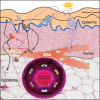Melanoma: Stem cells, sun exposure and hallmarks for carcinogenesis, molecular concepts and future clinical implications
- PMID: 20442802
- PMCID: PMC2862505
- DOI: 10.4103/1477-3163.62141
Melanoma: Stem cells, sun exposure and hallmarks for carcinogenesis, molecular concepts and future clinical implications
Abstract
Background: The classification and prognostic assessment of melanoma is currently based on morphologic and histopathologic biomarkers. Availability of an increasing number of molecular biomarkers provides the potential for redefining diagnostic and prognostic categories and utilizing pharmacogenomics for the treatment of patients. The aim of the present review is to provide a basis that will allow the construction-or reconstruction-of future melanoma research.
Methods: We critically review the common medical databases (PubMed, EMBASE, Scopus and Cochrane CENTRAL) for studies reporting on molecular biomarkers for melanoma. Results are discussed along the hallmarks proposed for malignant transformation by Hanahan and Weinberg. We further discuss the genetic basis of melanoma with regard to the possible stem cell origin of melanoma cells and the role of sunlight in melanoma carcinogenesis.
Results: Melanocyte precursors undergo several genome changes -UV-induced or not- which could be either mutations or epigenetic. These changes provide stem cells with abilities to self-invoke growth signals, to suppress antigrowth signals, to avoid apoptosis, to replicate without limit, to invade, proliferate and sustain angiogenesis. Melanocyte stem cells are able to progressively collect these changes in their genome. These new potential functions, drive melanocyte precursors to the epidermis were they proliferate and might cause benign nevi. In the epidermis, they are still capable of acquiring new traits via changes to their genome. With time, such changes could add up to transform a melanocyte precursor to a malignant melanoma stem cell.
Conclusions: Melanoma cannot be considered a "black box" for researchers anymore. Current trends in the diagnosis and prognosis of melanoma are to individualize treatment based on molecular biomarkers. Pharmacogenomics constitute a promising field with regard to melanoma patients' treatment. Finally, development of novel monoclonal antibodies is expected to complement melanoma patient care while a number of investigational vaccines could find their way into everyday oncology practice.
Keywords: Biomarkers; carcinogenesis; melanoma; melanomagenesis; stem cells; sunlight; ultra violet light exposure.
Figures


Similar articles
-
Ignored hallmarks of carcinogenesis: stem cells and cell-cell communication.Ann N Y Acad Sci. 2004 Dec;1028:192-201. doi: 10.1196/annals.1322.023. Ann N Y Acad Sci. 2004. PMID: 15650245 Review.
-
Black and Brown Oro-facial Mucocutaneous Neoplasms.Head Neck Pathol. 2019 Mar;13(1):56-70. doi: 10.1007/s12105-019-01008-2. Epub 2019 Jan 29. Head Neck Pathol. 2019. PMID: 30693458 Free PMC article. Review.
-
Role of In Vivo Reflectance Confocal Microscopy in the Analysis of Melanocytic Lesions.Acta Dermatovenerol Croat. 2018 Apr;26(1):64-67. Acta Dermatovenerol Croat. 2018. PMID: 29782304 Review.
-
Simulation of UV power absorbed by follicular stem cells during sun exposure and possible implications for melanoma development.J Opt Soc Am A Opt Image Sci Vis. 2019 Apr 1;36(4):628-635. doi: 10.1364/JOSAA.36.000628. J Opt Soc Am A Opt Image Sci Vis. 2019. PMID: 31044982
-
Biomarkers for personalized oncology: recent advances and future challenges.Metabolism. 2015 Mar;64(3 Suppl 1):S16-21. doi: 10.1016/j.metabol.2014.10.027. Epub 2014 Oct 30. Metabolism. 2015. PMID: 25468140 Review.
Cited by
-
The role of microRNAs and long non-coding RNAs in the pathology, diagnosis, and management of melanoma.Arch Biochem Biophys. 2014 Dec 1;563:60-70. doi: 10.1016/j.abb.2014.07.022. Epub 2014 Jul 24. Arch Biochem Biophys. 2014. PMID: 25065585 Free PMC article. Review.
-
Does melanoma begin in a melanocyte stem cell?J Skin Cancer. 2012;2012:571087. doi: 10.1155/2012/571087. Epub 2012 Dec 18. J Skin Cancer. 2012. PMID: 23316368 Free PMC article.
-
Medullospheres from DAOY, UW228 and ONS-76 cells: increased stem cell population and proteomic modifications.PLoS One. 2013 May 24;8(5):e63748. doi: 10.1371/journal.pone.0063748. Print 2013. PLoS One. 2013. PMID: 23717474 Free PMC article.
-
Increased expression of melanoma stem cell marker CD271 in metastatic melanoma to the brain.Int J Clin Exp Pathol. 2014 Dec 1;7(12):8947-51. eCollection 2014. Int J Clin Exp Pathol. 2014. PMID: 25674270 Free PMC article.
-
Physical activity, cardiorespiratory fitness and risk of cutaneous malignant melanoma: Systematic review and meta-analysis.PLoS One. 2018 Oct 31;13(10):e0206087. doi: 10.1371/journal.pone.0206087. eCollection 2018. PLoS One. 2018. PMID: 30379884 Free PMC article.
References
-
- Ugurel S, Utikal J, Becker JC. Tumor biomarkers in melanoma. Cancer Control. 2009;16:219–24. - PubMed
-
- Meyle KD, Guldberg P. Genetic risk factors for melanoma. Hum Genet. 2009;126:499–510. - PubMed
-
- Horner MJ RL, Krapcho M, Neyman N, Aminou R, Howlader N, Altekruse SF, Feuer EJ, Huang L, Mariotto A, Miller BA, Lewis DR, Eisner MP, Stinchcomb DG, Edwards BK, editors. SEER Cancer Statistics Review. Bethesda, MD: National Cancer Institute; 1975-2006.
-
- Hocker TL, Singh MK, Tsao H. Melanoma genetics and therapeutic approaches in the 21st century: moving from the benchside to the bedside. J Invest Dermatol. 2008;128:2575–95. - PubMed
-
- Society AC. Cancer Facts and Figures 2009. Atlanta: American Cancer Society; 2009.
LinkOut - more resources
Full Text Sources
Other Literature Sources

